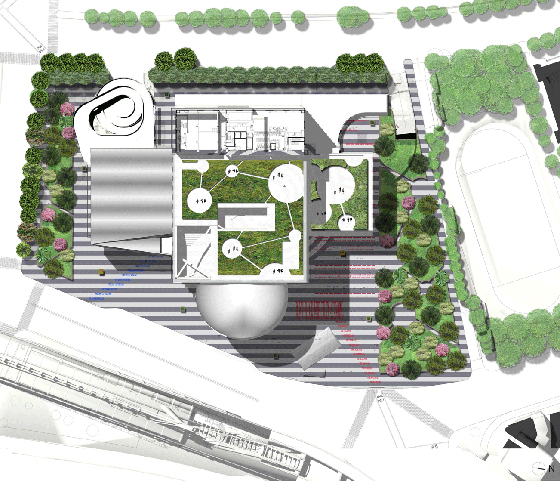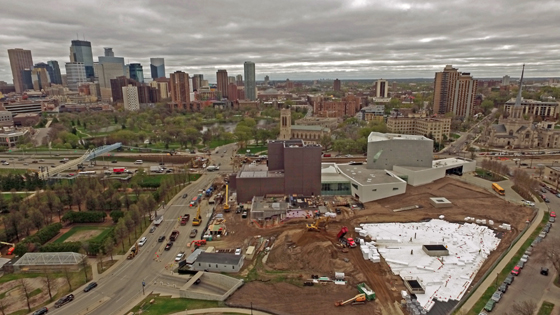The Constant Gardener: Petra Blaisse
Text by Madeline Bouton
Berlin, Germany
24.07.17
Founder of multi-disciplinary studio Inside Outside Petra Blaisse discusses how, as a landscape designer, she addresses existing situations and structures – revealing a deep respect for change, chance and circumstance.
The Water Recipe Garden in Qatar is a collection of habitats with different indigenous plants
Petra Blaisse is the founder and lead designer of Inside Outside, a multi-disciplinary studio specialising in landscape design as well as interior and exhibition design. Whether designing private gardens or public master plans, the studio’s main tools are always colour, light, sound and time.
Architonic asked Blaisse – who was one of the esteemed guests at this year’s Boisbuchet summer workshops – about her creative process, sustainable architecture and if there is a thread running through her work.
The landscape design of the Walker Art Center in Minneapolis should improve visibility of important points and of circulation through the old (Barnes) and the new (Herzog & de Meuron) wings and gardens

The landscape design of the Walker Art Center in Minneapolis should improve visibility of important points and of circulation through the old (Barnes) and the new (Herzog & de Meuron) wings and gardens
×You work in and around existing architecture. How does that affect your creative process?
Our work addresses both existing situations or buildings (if we are developing urban plans; or when asked to add acoustic, spatial or shading objects inside existing buildings; or collaborating on restoration projects) and projects that are in development. Most often we are part of an architecture team, involved from the conceptual phases of a project onward.
As our work, both inside and outside, is site specific and occurs in varied cultural, physical and climatological contexts, each commission, place and collaboration triggers a different approach and result.
The landscape-design concept for the Taipei Performing Arts Center creates an open and flexible space around the theatre building, with green planting concentrated in two slightly raised gardens along the South and North flanks

The landscape-design concept for the Taipei Performing Arts Center creates an open and flexible space around the theatre building, with green planting concentrated in two slightly raised gardens along the South and North flanks
×When you start a new landscape project, what is the first step?
We first visit the site to ‘feel’ its atmosphere and to understand its scale, physical potential and context. We then study all that is of value to find a direction for the ‘design’: history, biology, ecology, climate, local culture, the parties involved, purpose of the place, future users, future developments, local professional input, available budgets and future maintenance levels.
Could you say there is a continuous thread running through your projects?
Maybe it is in their graphic strength, a very readable organisation and structure, dictated by trajectories (efficient/linear or romantic/lyrical), logistics (traffic and infrastructure) and the necessity to guarantee readability of the design intent, and the spatial and planting organisation through time.
A certain clarity, which I call the ‘graphic quality’, proves to be important in surviving many forms of ‘abuse’, which are unavoidable in an urban context where everything changes. Also, economic gain, and therefore minimal investment, versus maximum income is the rule.
The planting beds at the Qatar's Water Recipe Garden measure from 14.4m to 6.6m square by 0.45m to 1.2m deep, allowing for a broad range of variegated biotopes, each consisting of a variation of plants that complement and stimulate each other

The planting beds at the Qatar's Water Recipe Garden measure from 14.4m to 6.6m square by 0.45m to 1.2m deep, allowing for a broad range of variegated biotopes, each consisting of a variation of plants that complement and stimulate each other
×At the same time, we have managed to introduce, hidden within the ‘simple plan’, complexity in the form of layers that provide information, sensation, seasonal change and aesthetic surprises, avoiding predictability, triggering curiosity and actively involving users and visitors in one way or another.
How do you ensure a design will be sustainable – both environmentally and socially?
One cannot guarantee the sustainable quality of a landscape site that one designs over time: a designer is but the first step of a process that will evolve further over many years. Lots of parties are involved – clients, users, maintenance people, residents, civil servants and politicians – through generations. They need to help sustain and, hopefully, to improve the area, the public park or botanic garden by paying constant attention, by organising financing, knowledge and professional care.
© Architonic
















